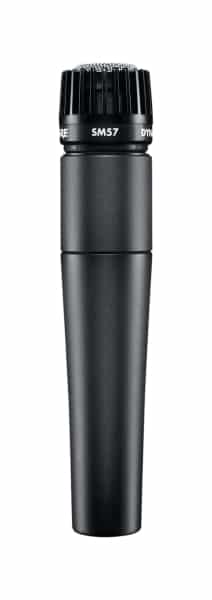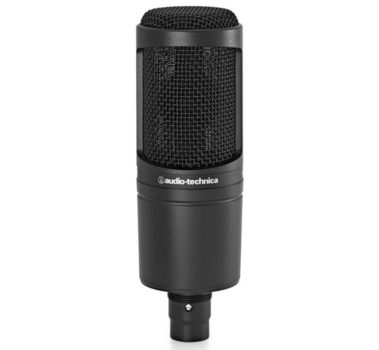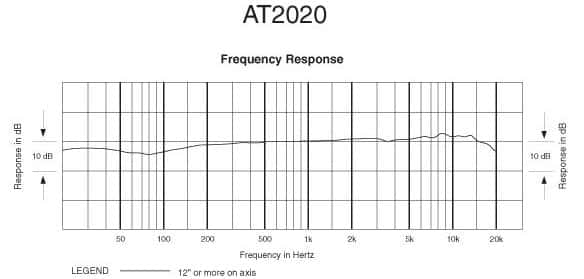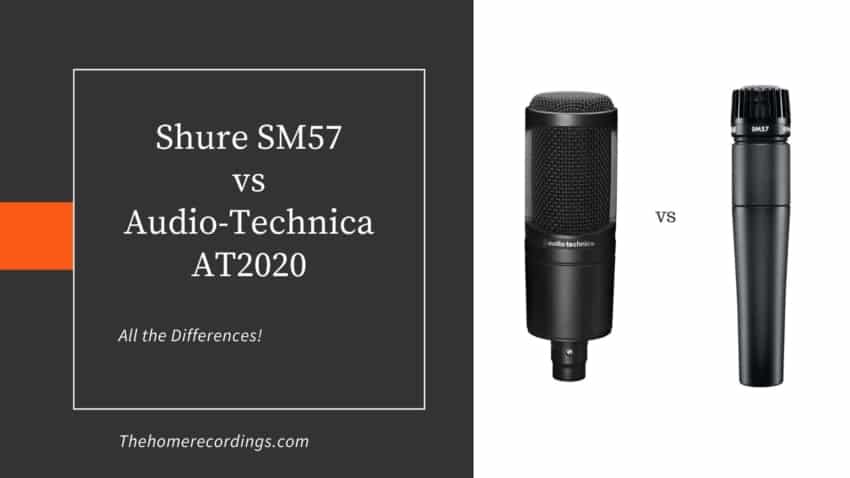Last updated on December 29th, 2023 at 09:58 pm
If there’s two microphones on the market that get mentioned everywhere, it’s the Shure SM57 and the Audio-Technica AT2020… and the Shure SM58 as well, of course.
There are some clear differences between these two microphones, especially in that one of them is a condenser mic and the other one is a dynamic mic, and I will cover all of these differences in this article, as well as give you some insight on which one to get depending on your needs.
Note: If you don’t know the differences between the Shure SM57 and the SM58 and would like to know more, check this post.
Let’s get started.
Shure SM57 vs Audio-Technica AT2020
The Shure SM57 is a Dynamic microphone that has a frequency response of 40Hz to 15kHz and it’s designed to record instruments and to be used on a live setting.
The AT2020 is a condenser microphone, has a frequency response of 20Hz to 20kHz, and it’s designed for studio use, mainly recording vocals.
Shure SM57

Used to record guitar and bass cabinets, drums -especially snares-, and loads of other instruments all over the world, the SM57 is considered to be the best dynamic microphone for recording instruments.
The reason the SM57 is used for recording instruments is because of the grille:
The SM57 has a built-in grille that’s actually part of the cartridge, which means that the diaphragm of the microphone can be placed a bit closer to the sound source, whereas on other dynamic microphones that have a ball grille that also works as a regular pop filter, you can’t get it as close.
The closer the sound source, the more pronounced the proximity effect will be. So, you could say that the SM57 has a more pronounced proximity effect than most other dynamic microphones.
First, let’s talk about the build quality:
The SM57 is built like an absolute truck; it can literally withstand anything you throw at it like being dropped on the ground, bumps, spills, and much more.
The reason for this is that it needs to be able to survive live shows and the life on the road, so it was designed to do just that.
The SM57 has an increased presence peak, which would be in the higher mids/high frequencies.
This means that vocals, for example, will cut better through the mix, and so will electric guitars.
How does it perform?
I use the SM57 to record almost anything, and it really is a very versatile microphone since it can be used on vocals, with a good pop filter in front of it otherwise the plosives will be too much, on electric guitar cabinets, to record drums, and it’s designed to be used both in the studio and on stage, which is something the AT2020 can’t really accomplish.
I love recording my electric guitar with it since the sound is clear, warm and also has a nice low-end.
I also record my cabinets with condenser mics from time to time depending on what the song needs, but I generally end up going back to the SM57.
In some cases, the SM57 ends up being better for vocals than even my Rode NT1-A, but this all depends on the vocalist and what the song needs.
Features
- Most Popular dynamic mic in the world
- Great at recording almost any instrument
- Excellent for close-miking
- Perfect for studio and live shows
Specifications
| Polar Pattern | Cardioid |
| Microphone type | Dynamic |
| Frequency Response | 40 to 15,000 Hz |
| Output Impedance | Rated impedance is 150 Ohms (300 Ohms actual) |
| Connector | Three-pin (XLR), male |
| Sensitivity | -56dB |
Find out more about the Shure SM57 here:
- Shure SM57: Amazon, Sweetwater, Guitar Center.
Now, let’s have a quick look at the AT2020.
Audio-Technica AT2020

There are probably few better-known brands in the music industry than Audio-Technica, or Shure for that matter.
They make some of the best microphones on the market and the AT2020 is the go-to mic for almost every beginner home recording enthusiast.
Plus, you won’t see a studio that doesn’t at least have a couple of them…
The AT2020 is a cardioid condenser microphone, which means that it is going to need phantom power in order to work properly… Like all condenser microphones.
More on this in a bit…
Just like all the Audio-Technica microphones, the AT2020 is extremely well built.
When holding it in my hand it doesn’t feel like a cheap product at all, quite the opposite in fact.
However, since it’s a condenser microphone, I wouldn’t recommend dropping it or not taking special care of it since condenser microphones tend to be a bit more sensitive in this sense than dynamic mics, so keep this in mind.
The AT2020 can be used for a lot of different applications, such as;
Recording music (mostly vocals), doing voice-over work, streaming, creating YouTube videos, and more.
Since the Audio-Technica AT2020 has a Cardioid pickup pattern, it will mostly be picking up sound from the front while rejecting sound from the back and the sides.
This is essential because you want to avoid picking up unwanted noises and any of the room’s natural sound, and a cardioid pattern will help with this quite a lot!

It has a frequency response of 20Hz-20kHz which is standard for almost every large diaphragm condenser microphone out there.
Important note: In the beginning I mentioned that in order to record properly, the AT2020 will need a phantom power supply.
The good news is that almost every modern Audio Interface, even the cheapest ones, will be able to supply it.
So, if you don’t already own an Audio Interface and are looking to purchase one, here are a couple articles I wrote that should be very helpful.
- Best Audio Interfaces under $300
- UMC22 Vs UM2 (Cheapest ones)
- Scarlett 2i2 vs UMC204HD (Higher quality and affordable)
- Scarlett 6i6 vs UMC 404HD (A bit more expensive but very cost-efficient)
How does it perform?
The recording quality is great, especially since this microphone costs only about $100.
It has a slightly reduced low-end which I personally don’t like for the simple fact that ends up lacking a bit of “body”, plus I prefer to control this in post later on.
The slight boost in the mid-high frequencies can actually help your vocals to better cut through the mix, which is always nice!
All in all, it’s a terrific mic to get if you’re on a budget!
Now, condenser microphones aren’t really that great for live shows since they are MUCH MORE prone to feedback.
This means that, when compared to the SM57, it’s less versatile.
What comes in the box?
- The Audio-Technica AT2020 Mic
- A storage Pouch
- Microphone Clip
Features
- Great Build quality
- High SPL handling and wide dynamic range provide maximum versatility
- Cardioid polar patter which reduces the overall noise picked up
- 144 dB SPL Handling
Specifications
| Polar Pattern | Cardioid |
| Microphone type | Condenser |
| Frequency Response | 20 to 20,000 Hz |
| Output Impedance | Rated impedance is 100 Ohms |
| Connector | Three-pin (XLR), male |
| Max SPL | 144dB SPL |
| Sensitivity | -37dB |
| Self-Noise | 20dB |
Find out more about the Audio-Technica AT2020 here.
Audio-Technica AT2020: Amazon, Sweetwater, Guitar Center.
Which one should you choose?
In all honesty, I’d recommend getting both, especially since they are super affordable.
However, if you can only get one, then it will depend on your needs.
For home recording artists who don’t need a microphone for live shows, the AT2020 might be a better fit, not only because it’s excellent at recording vocals, but also because recording acoustic instruments also tends to work better when using just one condenser mic instead of one dynamic mic.
The SM57 is also fantastic for home recording, especially if you want to record guitar- or bass cabinets, and it can definitely record vocals as well, plus it can also be used during live shows, but I think that for most people recording at home, the AT2020 is a better fit.
Now, if you don’t have the money to purchase both microphones, then here’s another mic that might suit your needs as well; The Shure SM48.
The Shure SM48 is a dynamic microphone, very similar to the Shure SM58, but it costs less than $50.
Conclusion
If you’re building a small home studio, then having at least one dynamic- and one condenser microphone should be on your list.
Even though you can use them to record the same instruments, and yes, you can even record drums with a well-placed condenser microphone, dynamic mics tend to do a better job at this.
If you’re only going to record vocals, then get a condenser mic.
On the other hand, if you need something more versatile, a dynamic microphone, like the SM57, will fit your needs best, especially considering that it can be used during live performances.
I hope this information was useful.
Have a wonderful day!
